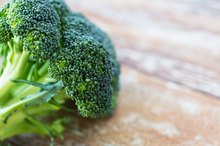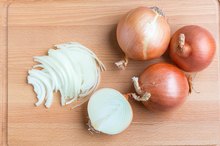Steamed Vegetable Nutrition
Steaming softens vegetables while maintaining most of their nutrients, especially water-soluble compounds that are easily damaged by heat. Whether you use an electric steamer, a bamboo steamer or a microwaveable plastic bag or dish, your vegetables will retain more texture, flavor and nutritional value when you prepare them with this indirect form of heat and moisture. The Centers for Disease Control and Prevention recommends steaming vegetables to make the most of their health benefits while preserving their low calorie and fat content.
Water-Soluble Vitamins
Water-soluble vitamins such as vitamin C, which boosts immunity and contributes to the structural formation of connective tissues; and the B vitamins, which promote healthy neurological function and glucose metabolism, may degrade when they have direct contact with boiling water. Steaming results in lower losses of these water-soluble vitamins, according to the American Council on Exercise, or ACE. To preserve vitamin content, gently boil a small amount of water in the lower compartment of your steamer, then allow raw vegetables to cook until slightly softened. Vegetables should never have direct contact with the boiling water. According to FoodReference.com, most vegetables require no more than five minutes to steam thoroughly. Monitor spinach and other leafy vegetables closely to make sure they don’t overcook.
Cancer-Fighting Compounds
How to Blanch Broccoli
Learn More
Cruciferous vegetables, such as broccoli, cauliflower, cabbage and bok choi, retain more of their cancer-fighting compounds when you steam them at low temperatures with a small amount of water, according to the Linus Pauling Institute. Cruciferous vegetables are rich in glucosinolates, water-soluble compounds that inhibit tumor formation and prevent the cellular damage caused by carcinogenic toxins. Boiling, steaming or microwaving these vegetables at high heat may leach 20 to 60 percent of their glucosinolates, Linus Pauling notes. Light steaming preserves these compounds, along with the enzymes that help your body break down glucosinolates during digestion.
Types
Almost any firm or leafy vegetable lends itself to steaming. To reap the health benefits of these nutritious foods, eat a wide variety of steamed vegetables, from asparagus and okra to green beans and red peppers. Broccoli and other dark green vegetables are rich in vitamin C and folate, a B vitamin involved in the preservation of cellular genetic material. Carrots and yellow squash offer vitamin A and betacarotene, which converts to vitamin A during digestion. Vitamin A supports immunity, promotes healthy eyesight and protects the integrity of your skin and other protective tissues that cover the surfaces of your body. Dark green, leafy vegetables such as kale, bok choi, spinach and mustard greens provide vitamins A and C, B-complex vitamins and potassium, an essential mineral that helps you maintain healthy blood pressure.
Calories and Fat
How to Blanch Leeks
Learn More
Steaming vegetables leaves them flavorful and firm, which means that you don’t need butter or fattening sauces to make them palatable. According to the American Dietetic Association’s food exchange list, one-half cup of cooked vegetables, such as carrots or zucchini, has 25 calories, 5 g of carbohydrate and no fat. Adding one tsp. of butter or margarine or one tbsp. of salad dressing to these vegetables would add 45 calories and 5 g of fat. Light herbal seasonings or citrus juices can bring out the flavors of steamed vegetables without adding fat, sodium or calories.
Related Articles
References
- Centers for Disease Control and Prevention: Healthy Eating for a Healthy Weight: Fruits and Vegetables
- Linus Pauling Institute at Oregon State University: Cruciferous Vegetables and Center Risk
- National Heart Lung and Blood Institute: Healthy Eating, Food Exchange Lists
- American Counsel on Exercise: How Much Difference Is There in Nutritional Value Between Fresh and Frozen Fruits and Vegetables?
- FoodReference.com: Steaming – Hot and Steamy – Food for Thought
Writer Bio
Anne Tourney specializes in health and nutrition topics. She is a registered nurse with experience in medical-surgical nursing, behavioral health and geriatrics. Tourney earned a Bachelor of Science in nursing from Regis University.









